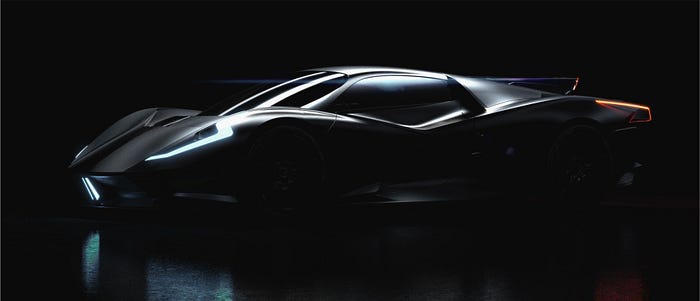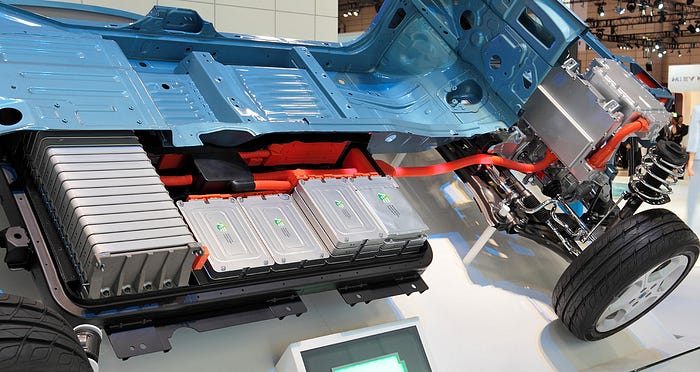|
Feb 12

The Electric Car More Groundbreaking Than Any Tesla
An EV startup is ready to turn the automotive world upside down.
Tesla has sat at the tippy-top of the EV world for over a decade now. No company can produce their blend of performance, range and technology. That is until Estrema, a new EV startup announced their upcoming car, the Fulminea. Underneath the elegant Italian bodywork lies pioneering technology that could spark an EV revolution. It might also be one of the fastest cars ever made. Welcome to the insane world of the Estrema Fulminea.
Before we dive into the astonishing technology behind the car, let's first get acquainted with what is a staggering feat of engineering.
The Fulminea is a two-seater hypercar with a 100 kWh hybrid battery pack comprised of solid-state batteries and ultracapacitors. This cutting edge pack gives the car 2,040 horsepower, a range of 323 miles and a 0–200 mph in under 10 seconds. For some comparison the Bugatti Chiron, one of the fastest cars around, can do 0–200 mph in 15.7 seconds.

I wasn't lying when I said the Fulminea could be the fastest car ever.
These monstrous figures are all down to that astonishing battery pack. Despite having a 100 kWh capacity it only weighs 300 kg. The 100 kWh pack in a Tesla Model S weighs 625 kg! By having such a dense and lightweight battery the Fulminea weighs almost nothing at 1,500 kg, whilst the Tesla Model S comes in at 2,200 kg.
Thanks to its next gen battery pack the Fulminea has four Porsche 911's worth of horsepower, but being lighter. This astonishing power-to-weight ratio is why the Fulminea is so damn fast.
But, the technology onboard goes much deeper and further than just an insanely rapid car. This 2.3 million dollar limited production run car (only 61 set to be made) will kickstart an EV revolution as it is a launchpad for new, world leading solid-state batteries, ultracapacitors and A.I battery management.
So what are solid-state batteries, ultracapacitors and A.I battery management? And why will they spark a revolution that is bigger than just the automative industry?
Let's start with solid-state batteries.
The lithium-ion batteries we have come to know consist of a cathode and an anode kept apart by a separator and a liquid electrolyte. Whilst they have served us well they do have their issues.
When being heavily discharged or recharged quickly metals can be deposited on the cathode forming spikes known as dendrites. As these dendrites grow they reduce the battery's capacity until it is practically useless. This process is known as degradation and it is why anyone buying a second-hand EV should be wary.

Solid-state batteries, on the other hand, don't have a liquid electrolyte. Instead, they have a solid one. Not only does this reduce the size and weight of the battery, but it also stops the degradation. In turn, this means the batteries can be pushed far harder and recharged faster, without damaging the capacity. So, whilst a lithium-ion battery EV might lose 25% of its range after only 80k miles of use, a solid-state EV should still have almost 100% left for the same distance.
This means solid-state EVs are far better for the environment as they have a much longer lifespan than lithium-ion ones. Another plus is that solid-state batteries are also more eco-friendly once they are dead too.
These batteries are also easy to recycle. The different battery layers can be easily separated and they don't randomly catch on fire like lithium-ion batteries. That is why it is impractical to recycle lithium-ion batteries at scale.
With their high density, huge performance, extreme longevity and ease of recycling, solid-state batteries seem to solve all of our current problems with lithium-ion.

The Fulminea will be the world's first road car to use these state-of-the-art batteries. Despite their advantages making these next gen batteries is very complex. That is why many companies went for the more traditional lithium-ion option. But, the Fulminea doesn't just use solid-state batteries to power itself, it also uses ultracapacitors.
At first glance, ultracapacitors seem a lot like batteries. They are devices that can store electrical energy and discharge it later. However, unlike batteries, they don't store it as chemical energy. Instead, they store it as pure electrical potential energy.
This less intricate storage method allows ultracapacitors to charge up and discharge at a rate far quicker than batteries. But the downside is that they can't hold onto that charge and slowly lose it. That is why ultracapacitors aren't used to power EVs on their own, despite being lighter and more energy-dense than batteries. However, they are perfect for sudden dumps of power or regenerative braking.
Most EVs have regenerative braking. The electric motors brake the wheels and use the cars' kinetic energy to charge their battery packs. But the level of charge is limited by how fast the battery can charge up. On the other hand, ultracapacitors can charge up so fast that almost all the braking force is turned into useful electrical energy. So, using ultracapacitors to store energy from braking can significantly increase the range of a car.

What's more, batteries can really struggle with sudden high loads. You can see this in many modern EVs whose battery packs overheat with repeated launches or repeated track driving. But by using ultracapacitors the demand on the battery can be averaged out and reduced. The ultracapacitors take the wildly varying loads and the battery pack focuses on keeping the ultracapacitors topped up. This way, more power is on tap and the health of the main battery pack isn't damaged by heavy driving.
But to make ultracapacitors work well with a battery pack takes a lot of work. They may seem simple, but the battery management system needs to be next gen, otherwise this cutting edge technology just won't work. Luckily Estrema has the solution. An A.I battery management system.
This type of system has been discussed for years, but this is the first time a road car receives such a powerful program. This A.I will use past data to maximise the performance of the battery pack while ensuring the health of the solid-state batteries isn't compromised.
This blend of batteries, ultracapacitors and A.I (together forming a hybrid battery pack) is what gives the Fulminea its outrageous performance and impeccable environmental impact. But this technology won't be limited to the Fulminea.

ABEE, the company that makes the batteries, has formed a merger with Estrema. The idea is that the production of the Fulminea will create the demand and the money to eventually build a full-scale solid-state gigafactory. That means this incredible technology could soon be available to many other vehicles like planes, cars and boats. All thanks to this awesome car!
This is where the Fulminea gets really exciting because it could change the way we live and travel.
What is the biggest problem with current EV's? They're slow charge times, quick battery degradation and limited range. The batteries being launched by the Fulminea will solve that.
What is the biggest thing stopping commercial electric planes or cargo ships? Current batteries aren't energy-dense enough. The Fulminea's batteries will solve that problem too.
This isn't just a car with the technology to threaten the likes of Tesla, Mclaren and Ferrari. This is a car with technology that could revolutionise the world by turning every aspect of society electric and zero emissions.

Unfortunately, we are a few years away from that. Whilst the Fulminea is amazing it is still being developed, which takes years, and even longer to scale production. Just look at how long it took Tesla. So it will be a while before we see the Fulminea, let alone any other vehicles with its technology.
However, what is mind blowing is that this blisteringly quick EV hypercar will kickstart a battery technology that is more eco friendly, more durable and way lighter than any we currently have. This incredible innovation really could start another EV revolution, taking us into a true zero emissions future. I don't know about you, but I can't wait to watch it happen.
|



No comments:
Post a Comment